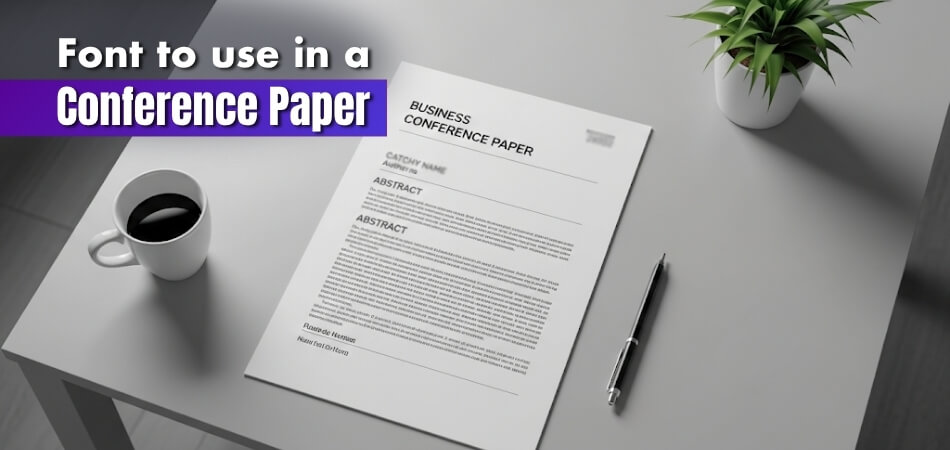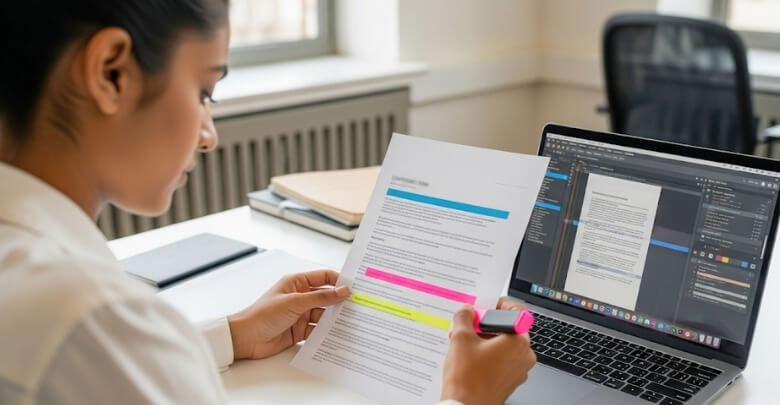The font you use for a conference paper might seem like a small detail, but it can make a big difference in how your work is seen. A good font choice can help your ideas stand out and show your work in the best possible way. Many people have this question in mind: What font should you use in conference paper?
Times New Roman, Arial, or Calibri in size 10 or 12 is usually the best font for a conference paper is usually. Always check the conference’s guidelines because they might require a specific font or size. Serif fonts like Times New Roman are great for print, while Arial and Calibri work well on digital papers. Simple, clean fonts make your paper easy to read.
Readers who are interested in making their paper look more professional or want to understand every small detail about font choice will find everything they need here. This article covers all the important information about conference paper fonts. You’ll find helpful tips, clear rules, and common mistakes to avoid.
What Font Should You Use in a Conference Paper?
Many people forget that picking a font is important for conference papers. The right font makes your work easier to read and more professional. This small detail can help your ideas shine and stand out. If you want to know which fonts are best, keep reading below!
Font Choice Matters
Everyone likes papers that look neat and tidy with clear writing throughout. The font you choose gives your paper a polished look and a professional feel. Simple fonts keep your ideas clear, so readers focus on your words. Avoiding fancy fonts really helps everyone read your work better. Most people choose basic fonts for this reason alone. Picking the right font makes your writing easier for anyone to understand.
Clear Fonts First
Choosing a font that is easy to read is always the safest choice here. Many people use Times New Roman because it is well-known and looks nice. Other clear fonts also work great, but always pick one that isn’t distracting. Readers will find your work easier to follow with a simple font. Keeping your paper readable makes a good first impression on everyone. Simple fonts make long papers much less tiring to read.
Stick to Guidelines
Always check the rules before picking any font for your paper. Sometimes, you will have to use a specific font or size for submission. If you’re preparing for global events like conferences in USA, Canada, or any other country, look for the official instructions first. Following the guidelines keeps your paper from being rejected by organizers. Matching the format helps everyone understand your work quickly and easily. Good formatting really matters at every conference.
Serif or Sans-serif
You might notice some fonts have little lines at the ends of letters. These are called serif fonts, and examples include Times New Roman and Cambria. Fonts without those lines are called sans-serif, like Arial or Calibri. Printed papers often use serif fonts because they look classic and traditional. Sans-serif fonts are great for digital reading and clean designs. Picking between them depends on the look you want for your paper.
Popular Font Choices
Times New Roman is a favorite for many conference papers across different subjects. Arial and Calibri look modern and are often used in digital formats. Cambria and Georgia are excellent if you like a classic style with good readability. Choosing one of these common fonts keeps your paper looking smart and professional. All of them are clear and work well for long documents. Any of these will help your paper look its best.
Font Size Matters Too
Body text is usually easiest to read when it is 10 or 12 points. Headings can be a bit larger so they stand out clearly for the reader. Captions under tables or figures are usually a little smaller, around 8 or 10 points. Keeping these sizes consistent across your paper is really important. Small changes can make the layout look messy or hard to read. Neat font sizes help everything look well-organized and easy to follow.
Avoid Fancy Fonts
People sometimes want to use decorative fonts, but that makes reading harder. Fancy or strange fonts can make your paper look messy or less professional. Basic fonts are easier on the eyes for everyone reading your work. Readers can stay focused on your ideas instead of the font style. Keeping your font simple will help your writing stand out instead. The best papers always use clear, readable fonts from start to finish.
Use One or Two Fonts
It can be tempting to try out different fonts in your paper for variety. Sticking to just one or two fonts makes the paper look much neater. Use one font for your main text and maybe another for your headings. Too many fonts can make your work look confusing and unprofessional. Having a simple, clean look helps people understand your writing. Mixing many fonts is not a good idea for any conference paper.
Double-Check Before Submitting
Always take a moment to check your paper before you submit it. Look at your font and size to make sure they match the rules. Even small mistakes with formatting can cause problems with your submission. Checking everything before turning in your work saves you from trouble. Good formatting gives you the best chance of your paper being accepted. Submitting your best work always feels great in the end.
Simple fonts make conference papers easier for everyone to read and enjoy. Checking font rules before starting your paper is always a smart idea. Take a few minutes to pick and check your font choices carefully. Good formatting and neat fonts help your ideas shine every single time.
Why Font Choice Matters in Conference Papers?
When you look at a conference paper, the font is one of the first things you notice. The font choice does more than just make words appear on the page. There’s a lot more behind it, and it can really change how your paper is received. Let’s take a closer look at why the font you pick is so important.
Readability Factor
A good font makes your paper easy to read. If the letters are clear and not too fancy, people can understand your ideas quickly. On the other hand, if the font is too small, crowded, or hard to read, people might lose interest or miss important points. Simple and clean fonts help readers focus on what you are saying without getting distracted.
Professional Look
The right font gives your paper a smart and neat look. When your paper looks tidy, people take your work more seriously. Messy or playful fonts can make your paper seem less important. Choosing a professional font shows you care about how your work is presented and that you respect the rules of the conference.
Following Rules
Most conferences have certain guidelines for formatting, including which fonts to use. If you follow these rules, it shows you can pay attention to details. Ignoring font guidelines may make it look like you didn’t read the instructions or don’t care about the conference rules. It’s a small thing, but it matters a lot.
Making a Good Impression
Your font choice is part of the first impression you give. Before people even start reading, they see the style of your paper. A clear and simple font invites people in and makes them want to keep reading. A bad font can make them think twice before taking your paper seriously.
Easy on the Eyes
Long conference papers can be tough to read if the font is uncomfortable. The right font helps readers stay focused for longer. It reduces eye strain and makes the whole experience smoother. People are more likely to finish reading your paper if it’s comfortable to look at.
Choosing the right font in your conference paper does more than fill a page with words. It makes your work readable, professional, and pleasant to read. Paying attention to font choice can make a big difference in how your paper is received.
How Submission Guidelines Influence Your Formatting Decisions for Conference Paper?
Conference paper formatting rules can feel confusing at first glance. These rules help everyone’s papers look neat and easy to read. Font choices and layout are important in making your paper look professional. Keep reading to see how guidelines can affect every formatting decision you make.
Font Matters
Many conferences are very clear about the fonts they want you to use. A common choice is Times New Roman or Arial in a set size. Picking the right font helps all papers look neat and organized. The wrong font might even get your paper sent back for changes. Guidelines like this help readers focus on the content instead of your style choices.
Guidelines for Proposals
Often, the first stage has relaxed formatting rules compared to the final paper. Many conferences provide specific formatting rules not only for final submissions but also when you write a conference paper proposal, which may have lighter font and layout requirements during the review stage. There is more focus on sharing your idea than perfect formatting in this stage. Light rules make it less stressful and easier to submit early work.
Final Submission Rules
After your proposal is accepted, the requirements become much stricter and more detailed. You may have to follow rules for margins, font size, and spacing exactly. Even small mistakes could lead to your paper getting rejected or needing edits. These details help every paper match the style expected by the event. Taking time to follow these rules makes your work look much more professional.
Paper Layout Decisions
Organizers often tell you how to set up different sections in your paper. They might want your paper split into introduction, methods, results, and conclusion. Headings and subheadings can also have specific formatting needs to meet. When you follow these instructions, your paper looks tidy and organized for every reader. Keeping things structured makes your ideas clearer and easier to understand for everyone.
Importance of Consistency
Using the same style all the way through makes your paper easier to read. Font, spacing, and heading size should not change from start to finish. Sudden changes in style make it harder for people to follow your work. Guidelines help make sure all papers at the conference look very similar. Consistent formatting gives your paper a smooth, professional, and polished appearance every time.
Submission guidelines might look difficult at first, but get easier over time. Following every rule makes your paper clear and easy for people to read. Neat and tidy papers help your ideas stand out from the rest. Always read the instructions before you start and check them again before you submit.
What Fonts to Avoid in Conference Papers?
Fonts can make a big difference in how your paper looks and feels. Some fonts just don’t work well for serious or important writing. Picking the wrong font can distract your reader and make your paper look less trustworthy. Here are fonts that should be avoided in conference papers:
- Comic Sans: This font looks playful and silly, which makes your paper appear less serious and not professional for academic work.
- Papyrus: With its rough, old-style design, this font feels out of place in formal writing and can make your paper seem less polished.
- Script or Cursive Fonts: These look like handwriting and can be hard to read in big paragraphs, making your ideas less clear to readers.
- Decorative or Novelty Fonts: Fonts that are extra fancy or wild can distract from your ideas and look messy or loud on a serious paper.
- Fonts That Are Too Thin or Heavy: Extreme thick or thin fonts strain the eyes and are not comfortable for reading lots of text at once.
- Overly Condensed or Expanded Fonts: Fonts that are squished together or stretched out make words hard to read and can break up the flow of your writing.
- Monospace Fonts for Main Text: Using these typewriter-style fonts makes your writing look blocky and is not easy to read for normal paper sections.
Choosing the right font style helps your paper look sharp and easy to read. Avoiding certain fonts keeps your writing looking neat and professional. A good font lets your ideas shine without distractions. Pick wisely so your work stands out for the right reasons.
How Font Formatting Reflects Your Preparation for the Conference Paper?
People often notice the look of your paper before reading a single word. A neat and clean format shows you have spent time on your work. Picking the right font can help your ideas stand out clearly. Keep reading to see how font formatting really matters for your paper.
Attention to Detail
Readers always notice when you pay attention to small details in your paper. Your paper looks more organized when your font style and size stay the same. A random mix of fonts can make everything look rushed and messy. Good formatting makes it easier for everyone to understand your main points. Keeping everything in order shows that you have checked your work twice.
Reflects Your Professionalism
A professional-looking paper gives people a strong first impression of your work. Clean and simple fonts make your writing seem smart and serious from the start. Messy or playful fonts can make your paper look less important and careless. If you choose fonts well, people will trust your effort. The font you use says a lot about your attitude toward your work.
Creates First Impression
When people look at your paper, the first thing they notice is its layout. Readers decide quickly if your paper looks trustworthy just by seeing the font. Clean and neat formatting makes people want to read your ideas carefully. A clean, well-formatted paper—using consistent fonts and layout—sets a professional tone before you even speak. But to leave a lasting impression, it’s equally important to practice before presenting at a conference, ensuring your delivery matches the polish of your document.
Highlights Your Efforts
Putting extra time into your formatting makes your work look even better. Careful font choices show you didn’t leave your paper unfinished or in a hurry. Even the smallest details matter, especially when it comes to academic work. People can see your hard work just from the way your paper is presented. This helps them understand you took your task seriously from start to finish.
Boosts Reader Engagement
It gets easier for readers to enjoy your work when your formatting is clear. They won’t have to struggle with hard-to-read fonts or jumbled text. Fonts that are easy on the eyes keep people reading longer. Good formatting keeps their attention on your ideas, not the layout. A well-formatted paper helps everyone focus on your main points easily.
Neat formatting shows you care about your paper from beginning to end. Good font choices make your ideas look organized and professional. Your hard work shines through when your paper is easy to read. These small choices leave a strong and lasting impression.
Frequently Asked Questions
There are always some small but important questions people have about choosing fonts for conference papers. Picking the right font goes beyond just following rules; it also helps your paper look clear and professional. Here are some of the most common questions and easy answers about fonts for conference papers. These tips will help you make your paper even better!
Can I Use Colored Fonts in My Paper?
Most conferences want papers in black text only. Colored fonts might look fun, but are hard to read and can distract from your ideas. Sticking to black text makes your paper look formal and neat. Always use color only if the guidelines clearly allow it.
Are Italics Good for Emphasis?
Italics are a good way to highlight important words or terms. However, using italics too much can make your paper look messy. Use italics for special terms, book titles, or when you need to show emphasis. Too much italics can be hard to read for long texts.
Should Headings and Body Text Use the Same Font?
You can use the same font for both, or use a different but simple font for headings. The most important thing is that both fonts are easy to read and look good together. Make sure the difference is not too distracting. Keeping a similar style makes your paper look well-organized.
Is Bold Font Good for Important Points?
Bold text helps highlight headings or key points in your paper. It should not be used too much in regular sentences, or it will lose its effect. Only bold the most important things you want readers to notice. Too much bold text can make your paper look unprofessional.
Can I Use Underlining in My Conference Paper?
Underlining is not commonly used in modern papers, except for web links. It can make words harder to read, especially when used too often. If you need to show emphasis, italics or bold are better choices. Only use underlining if the conference rules ask for it.
Should I Use All Caps for Headings?
All caps can help headings stand out, but they are not always easy to read. Too much all-caps writing feels loud and sometimes confusing. Use all caps only for short section titles, not for long sentences. Make sure your headings look neat and match the style of your paper.
Do Fonts Affect How Diagrams or Tables Look?
Yes, the font you use in diagrams or tables should match the rest of your paper. Using the same font style keeps everything looking organized and tidy. Mixing fonts in tables or diagrams can look confusing and messy. Always check your tables and figures before submitting.
How Should I Format Quotes in My Paper?
Short quotes can stay in the regular body font with quotation marks. Long quotes are usually set apart in a block with smaller or indented text. Don’t change the font just for quotes unless the rules say so. Keeping the same font helps the paper stay easy to read.
What About Font for References or Bibliography?
References should use the same font as the main text, unless the guidelines say differently. Using the same style makes your paper look consistent from start to end. Font size should also match the rest of the body text for easy reading. A neat references section leaves a good impression.
Can I Use Fonts With Special Effects or Shadows?
Fonts with shadows, outlines, or glowing effects are never good for academic papers. They can be very hard to read and look unprofessional in any serious writing. Stick with simple fonts with no extra effects. Special effects can distract readers from your ideas and main points.
Bottom Line
Choosing the right font for your conference paper can make a bigger difference than you think. A good font helps your ideas look clear and keeps readers interested in your work. When you follow formatting rules, your paper always looks neat, smart, and professional to everyone.
So, what font should you use in conference paper? The answer is simple: stick to easy-to-read fonts like Times New Roman, Arial, or Calibri, and follow any guidelines given by the conference. Picking a clear, basic font shows you care about your work and want everyone to understand it.
Before you finish, always double-check your font size, style, and spacing for mistakes. Avoid using too many different fonts, and never choose fancy or hard-to-read styles. Good luck with your conference paper—may your ideas shine bright and your paper stand out!








